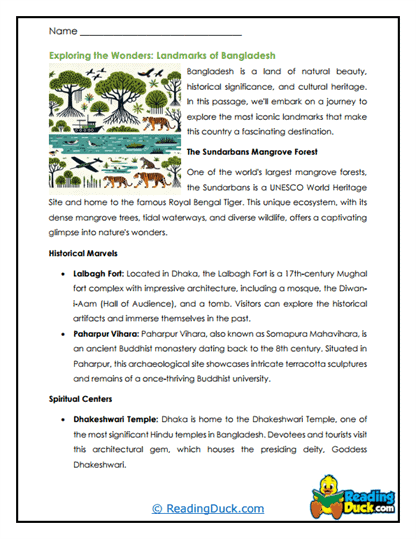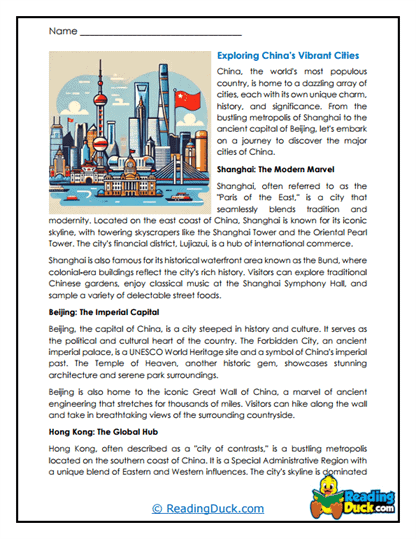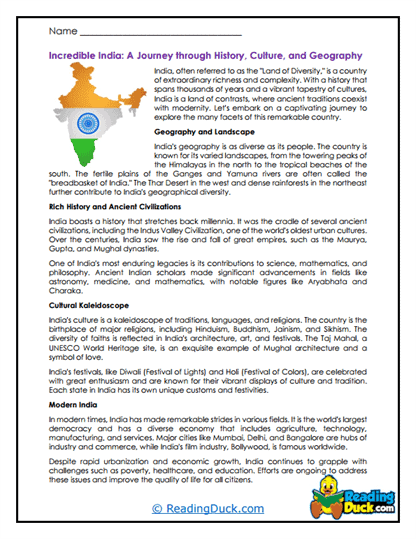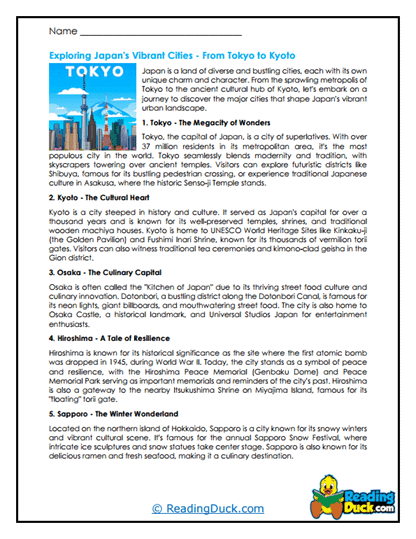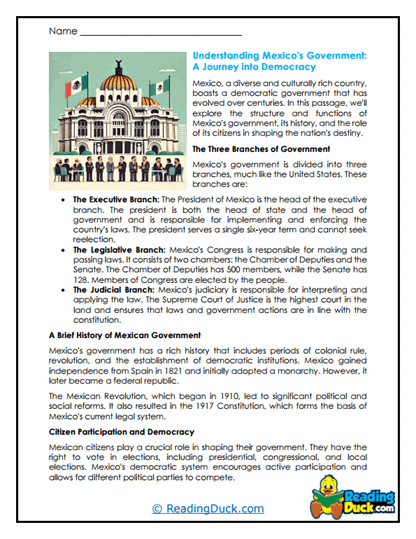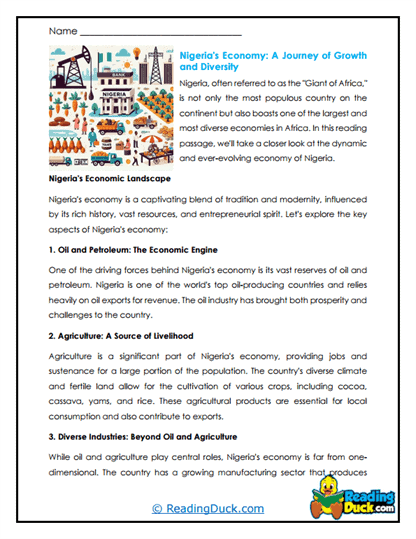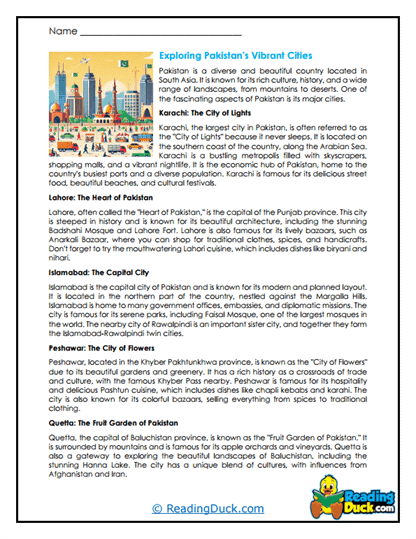Countries Worksheets
About Our Countries Worksheets
Our Countries worksheets offer an engaging and comprehensive exploration of the diverse nations around the globe, providing students with the opportunity to learn about geography, cultures, history, and global interconnections. Each worksheet set is designed to captivate students with visually appealing content and thoughtful questions that deepen their understanding of the world.
Every topic in this collection contains several worksheet sets, designed to cater to different learning styles and promote critical thinking:
- Multiple Choice Questions: These questions assess students' retention of key facts, such as capitals, languages, major historical events, and significant cultural practices.
- Short Answer Questions: Students are prompted to articulate their understanding of more complex ideas, such as the impact of colonialism, the role of geography in shaping a country's development, or the influence of religion and traditions.
- Open-Ended Questions: These questions encourage students to express their own interpretations, opinions, and preferences, fostering a personal connection and deeper reflection on the countries they study.
Each worksheet includes an answer key, making it easy for educators and parents to evaluate students' progress. All of the worksheets are available in PDF format, allowing for convenient electronic viewing, downloading, and printing.
Understanding the World: Exploring Countries and Cultures
1. Geography and Location:
- Understanding Physical Geography: Geography is the foundation for understanding how countries are formed and how their physical landscapes shape the lives of their inhabitants. Topics may include mountain ranges, rivers, climate zones, and how these factors influence agriculture, trade, and culture.
- Political Boundaries and Regions: Political geography covers the formation of countries, their borders, and how historical events like wars, treaties, and colonization have shaped the current map. This section can explore how political boundaries affect relations between neighboring countries.
2. Cultural Diversity:
- Languages and Dialects: Language is a key component of cultural identity. This section explores the major languages spoken in different countries, the diversity within them, and the impact of languages on cultural practices and communication.
- Religions and Beliefs: Religion plays a significant role in shaping the traditions, holidays, and daily lives of people around the world. Students can explore the dominant religions in various countries and how these belief systems influence culture and societal norms.
- Customs and Traditions: From festivals to food, clothing to rituals, every country has its own set of customs that define its cultural identity. This section can include detailed studies on how these customs have evolved and what they signify in today’s global society.
3. Historical Context:
- Colonialism and Independence: Many countries' histories are deeply intertwined with colonialism. This section can explore the impact of colonization on the political, social, and economic structures of countries, as well as the struggles and movements for independence.
- Wars and Conflicts: Understanding the history of conflicts, both internal and external, is crucial to understanding a country's present. This could include studies on world wars, civil wars, and other significant conflicts that have shaped a nation’s history.
- Economic Development: The historical context of a country's economic development—whether through industrialization, trade, natural resources, or innovation—can provide insights into its current economic status and global influence.
4. Governments and Political Systems:
- Types of Government: Students can learn about the different forms of government around the world, such as democracies, monarchies, dictatorships, and theocracies. Understanding these systems helps students appreciate the diversity of governance and the values that underpin them.
- Political Movements and Leaders: This section can cover significant political movements, revolutions, and the leaders who have shaped the political landscapes of various countries. Students can explore how these movements have led to changes in governance and society.
- International Relations: Countries do not exist in isolation. This part can explore how countries interact with one another through diplomacy, trade agreements, alliances, and international organizations like the United Nations.
5. Economic Systems and Globalization:
- Market Economies vs. Command Economies: An exploration of different economic systems and how they operate in various countries can provide students with a deeper understanding of global economics. Topics may include capitalism, socialism, mixed economies, and how these systems impact citizens’ lives.
- Global Trade and Interdependence: In today’s interconnected world, no country is truly independent. This section can delve into global trade networks, the role of multinational corporations, and how globalization has changed the way countries interact economically.
- Poverty and Development: Students can examine the economic disparities between countries, the factors contributing to poverty, and the efforts to promote development and reduce inequality on a global scale.
6. Environmental Challenges:
- Climate Change and Its Impact: Many countries face significant environmental challenges due to climate change. This section can explore how different regions are affected by climate change, including rising sea levels, extreme weather events, and their impact on agriculture and livelihoods.
- Natural Disasters: Understanding how countries prepare for and respond to natural disasters, such as earthquakes, tsunamis, and hurricanes, can provide insights into their resilience and disaster management strategies.
- Sustainability and Conservation: Students can learn about the efforts countries are making to promote sustainability, conserve natural resources, and protect endangered species, as well as the challenges they face in these endeavors.
The Role of Countries in World History and Their Global Impact
1. Significance in World History:
- Shaping Global Cultures: Countries around the world have contributed to the development of global cultures through art, literature, science, and philosophy. For example, the Renaissance in Italy, the Enlightenment in France, and the spread of Buddhism from India to East Asia have all had lasting impacts on world history.
- Global Conflicts and Resolutions: Major global conflicts, such as the World Wars, the Cold War, and regional conflicts, have significantly shaped the modern world. Understanding these events provides context for current international relations and global power dynamics.
- Influence on International Law and Human Rights: Countries have played critical roles in the development of international law and the promotion of human rights. The Universal Declaration of Human Rights, adopted by the United Nations, is an example of a global effort to establish a standard of human rights across all nations.
2. Economic and Technological Contributions:
- Industrialization and Innovation: Countries like the United Kingdom, the United States, and Japan have been at the forefront of industrialization and technological innovation, driving economic growth and transforming global economies.
- Globalization and Trade Networks: Countries have contributed to the development of global trade networks, which have facilitated the exchange of goods, services, and ideas across borders. This interconnectedness has led to increased economic interdependence and cultural exchange.
- Global Health and Education Initiatives: Countries have also contributed to global health and education initiatives, such as the eradication of diseases, the promotion of literacy, and the advancement of scientific research. These efforts have had a significant impact on global well-being and human development.
From Social Studies Classes and Beyond: Using Countries Worksheets Creatively
In Social Studies:
- Comparative Studies: Use the worksheets to have students compare and contrast different countries, focusing on their political systems, economies, cultures, and histories. This activity fosters critical thinking and global awareness.
- Geographical Mapping: Encourage students to create maps that highlight key geographical features, cultural landmarks, and historical events of different countries. This can help students visually connect with the content and reinforce spatial understanding.
Cross-Curricular Connections:
- Language Arts: Integrate the study of countries with language arts by having students read literature, poetry, or folk tales from various countries. They can then use the worksheets to explore the cultural context and themes within these texts.
- Art and Culture: Pair the worksheets with art projects where students create visual representations of cultural artifacts, traditional clothing, or historical events from the countries they study. This promotes creativity and cultural appreciation.
Critical Thinking and Discussion:
- Debates and Simulations: Use the open-ended questions to initiate debates or simulations where students take on roles as leaders, diplomats, or citizens of different countries. This encourages them to think critically about global issues and develop problem-solving skills.
- Ethical Discussions: Engage students in discussions about ethical dilemmas faced by different countries, such as human rights issues, environmental challenges, or economic inequality. These discussions can help students develop empathy and a deeper understanding of global responsibilities.
Interactive Learning and Technology:
- Virtual Tours and Global Connections: Pair the worksheets with virtual tours of famous landmarks, museums, and cultural sites around the world. This can enhance students' understanding of the countries they study and provide a more immersive learning experience.
- Digital Presentations and Research Projects: Encourage students to create digital presentations or research projects on specific countries, using the worksheets as a foundation for their work. These projects can be shared with peers or even presented in a school-wide showcase.
Home Learning and Family Engagement:
- Family Discussions and Activities: Encourage students to share what they’ve learned about different countries with their families. Families can explore cultural foods, traditions, and music from the countries studied, making learning a collaborative and enriching experience.
- Cultural Celebrations at Home: Organize a "Cultural Day" at home, where students and their families can celebrate the cultures of different countries through food, dance, and storytelling. This can make learning about world cultures a fun and memorable experience for everyone.
By integrating these Countries worksheets into your curriculum, you provide students with a broad and engaging exploration of the world's nations. This collection not only enhances students' knowledge of geography, history, and culture but also fosters global awareness, critical thinking, and a deeper appreciation for the diversity and interconnectedness of our world.
